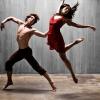OBJECTIVE: To test the feasibility, acceptability, and potential efficacy of after-school dance classes and a family-based intervention to reduce television viewing, thereby reducing weight gain, among African-American girls.
DESIGN: Twelve-week, 2-arm parallel group, randomized controlled trial.
SETTING: Low-income neighborhoods. PARTICIPANTS: Sixty-one 8-10-year-old African-American girls and their parents/guardians. INTERVENTIONS: The treatment intervention consisted of after-school dance classes at 3 community centers, and a 5-lesson intervention, delivered in participants' homes, and designed to reduce television, videotape, and video game use. The active control intervention consisted of disseminating newsletters and delivering health education lectures.
MAIN OUTCOME MEASURES: Implementation and process measures, body mass index, waist circumference, physical activity measured by accelerometry, self-reported media use, and meals eaten with TV.
RESULTS: Recruitment and retention goals were exceeded. High rates of participation were achieved for assessments and intervention activities, except where transportation was lacking. All interventions received high satisfaction ratings. At follow up, girls in the treatment group, as compared to the control group, exhibited trends toward lower body mass index (adjusted difference = -.32 kg/m2, 95% confidence interval [CI] -.77, .12; Cohen's d = .38 standard deviation units) and waist circumference (adjusted difference = -.63 cm, 95% CI -1.92, .67; d = .25); increased after-school physical activity (adjusted difference = 55.1 counts/minute, 95% CI -115.6, 225.8; d = .21); and reduced television, videotape, and video game use (adjusted difference = -4.96 hours/week, 95% CI -11.41, 1.49; d = .40). The treatment group reported significantly reduced household television viewing (d = .73, P = .007) and fewer dinners eaten while watching TV (adjusted difference = -1.60 meals/week, 95% CI -2.99, -.21; d = .59; P = .03). Treatment group girls also reported less concern about weight (d = .60; P = .03), and a trend toward improved school grades (d = .51; P = .07).
CONCLUSIONS: This study confirmed the feasibility, acceptability, and potential efficacy of using dance classes and a family-based intervention to reduce television viewing, thereby reducing weight gain, in African-American girls.
 Dancing or Dance is a performing art form consisting of purposefully selected sequences of human movement. This movement has aesthetic and symbolic value, and is acknowledged as dance by performers and observers within a particular culture. Dance can be categorized and described by its choreography, by its repertoire of movements, or by its historical period or place of origin.
Dancing or Dance is a performing art form consisting of purposefully selected sequences of human movement. This movement has aesthetic and symbolic value, and is acknowledged as dance by performers and observers within a particular culture. Dance can be categorized and described by its choreography, by its repertoire of movements, or by its historical period or place of origin.